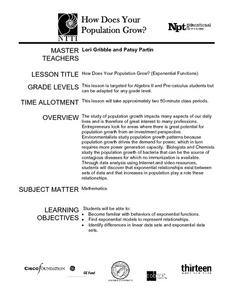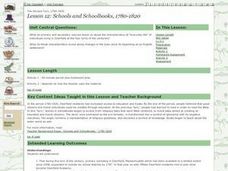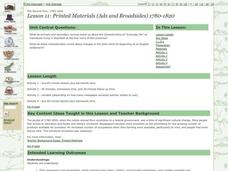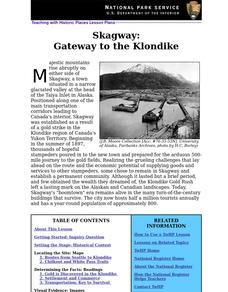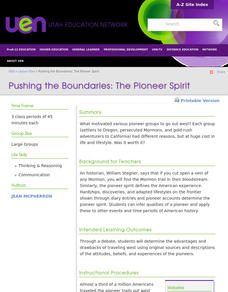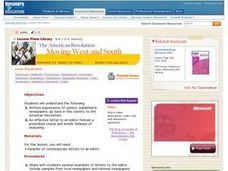Curated OER
How Does Your Population Grown?
Do you know how the population has grown of your community? Can you predict the population over the next half century? Can we find an algebraic model that matches our data? These along with many more questions can be researched by...
Curated OER
Immigration in the Connecticut River Valley
Students discuss and compare immigration during the 18th century to the Connecticut River Valley to that in America during the turn of the century.
Curated OER
Schools and Schoolbooks, 1780-1820
Students review 18th century New England schoolbooks to explain how changes occurred in early American education.
Curated OER
Lesson 11: Printed Materials (Ads and Broadsides) 1780-1820
Young scholars use primary resources (gazettes, broadsides, advertisements) to consider life at the turn of the 18th century in Deerfield, Massachusetts. They infer observations about life in the nascent United States.
Curated OER
BEGINNER LEVEL LESSON PLAN ANTICIPATORY SET
Students are be able to analyze primary sources for evidence of American entrepreneurship during the early 20th century. They identify the attributes that helped George Eastman succeed as an entrepreneur and consider the role advertising...
Curated OER
Understanding Tenement Life
Students look at life for immigrants in the 19th century. In this immigrant lesson plan, students discuss how the poor German, Irish, Italian, and Jewish immigrants lived in tenement housing. They research the reasons they came to...
Curated OER
Skagway: Gateway to the Klondike
Students explore the impact of the Klondike Gold Rush on the development of Skagway, Alaska. Lesson can be used in units on western expansion, late 19th and early 20th-century commerce, and urban history.
Curated OER
Mechanics Hall
Students complete a variety of activities that go along with the study of and possible fieldtrip to Mechanics Hall (Black River Valley) in Worcester, MA. They examine the role industrial development had in society at the turn of the...
Curated OER
The Red Studio Turns 100!
Learners observe the art of Henri Matisse and discuss the ideas and feelings his art brings about. In this Henri Matisse lesson plan, students look at many of his artistic paintings and discuss and write in a journal the point of view...
Curated OER
US Foreign Policy at the Turn of the Millennium
Learners explore U.S. foreign policy. For this diplomacy lesson, students discuss and analyze the evolution of U.S. foreign policy between 1970 and 2000. Learners research their textbooks, the Internet, videos, and filmstrips.
Curated OER
Turn off the TV: Vocabulary Skills
In this online interactive vocabulary skills worksheet, learners answer 10 fill in the blank questions regarding television-related words. Students may submit their answers to be scored.
Curated OER
What if Amelia Earhart had Turned Around?
Young scholars discuss an article in USA Today in which Gregg Zoroya proposes his theory about what happened to Amelia Earhart. In this reading comprehension and Amelia Earhart lesson, students read an article in USA Today...
Malibu High School
Create a Game – Extra Credit Chemistry Project
What a fun way to review the year's learning! Working in small groups, learners select a major concept covered in class then create a game about it. The type of game is up to each group, but the expectations of what should be included...
Curated OER
Pushing the Boundaries: The Pioneer Spirit
Eleventh graders recognize how social reform occurred at the turn of the century. Through a debate, 11th graders determine advantages and drawbacks of traveling west using original sources and descriptions of the attitudes, beliefs, and...
Curated OER
Food: Then and Now
Third graders examine turn-of-the-century cooking methods and research recipes from that period. They examine poems by Paul Lawrence dunbar about food and assemble their own class cookbook. They make gingerbread and butter in class.
Curated OER
Immigration in Massachusetts, 1880-1920
Students, in groups, research immigration in America at the turn of the century. They put together a series of original written essays, letters, newspaper columns, etc. that show what it was like to live as an American citizen and as an...
Curated OER
European Expansion in America
Students explore human settlement in America - from the 1500s to about the turn of the 20th Century. They follow the relationships and changes beginning in the east, then head west to witness the final battles of this era.
Curated OER
Inventors
Students are be able to analyze primary sources for evidence of Inventors and Inventions from the turn of the 20th century. They identify how these inventions impact their lives today.
National First Ladies' Library
Secretary of Commerce
Middle schoolers gain understanding of economic history of United States in twentieth century by examining role of Department of Commerce. Student groups each analyze one quarter of twentieth century by researching role of Department of...
Curated OER
Exploring the Soul of India
Students use websites to obtain information on the relationship between religion and current issues in India. They compare the information with pre-20th century India.
Curated OER
Food Chains
Students study food chains by creating their own slide show using KidPix. They compare information after sharing their slide shows as a whole group. As the children are watching the slide shows of their peers, they tally every time...
Curated OER
I've Felt the Same Way
Students recognize various differences between their lives and the lives of
people living in the 19th century Chicago area. They hear stories from people living in four different historical time periods and match the stories
to their...
Curated OER
The American Revolution: Moving West and South
Students examine several letters to the editor from both a local newspaper and national newspapers. After reviewing current letters, they write a letter to the editor of an 18th-century newspaper expressing their opinion about the...
Curated OER
Calculator Code Words 2
For this calculator code words worksheet, students practice solving twenty equations utilizing a calculator. Students then turn the calculator upside down and match the word they see with one of the clues given to each of them.
